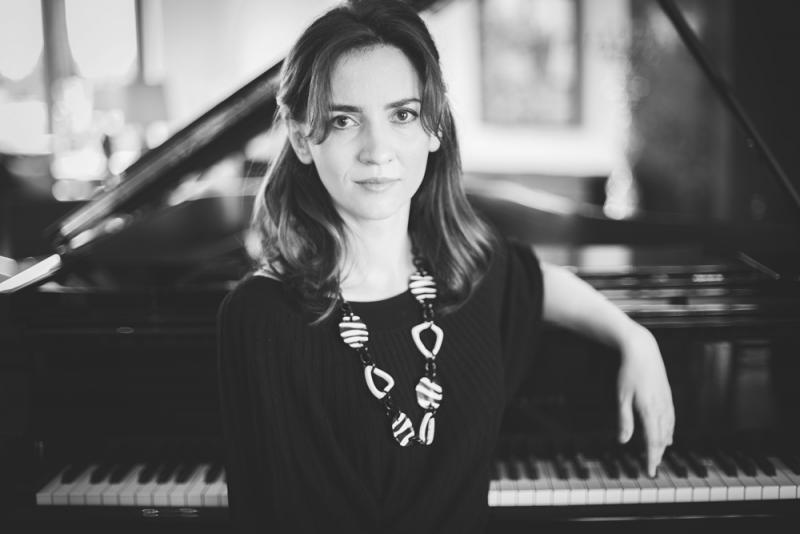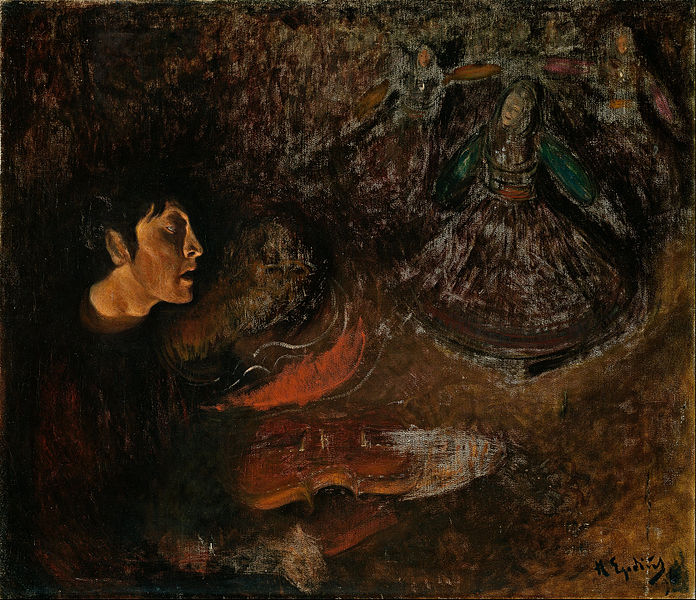Ivana Gavrić, Wigmore Hall review - more earth than air | reviews, news & interviews
Ivana Gavrić, Wigmore Hall review - more earth than air
Ivana Gavrić, Wigmore Hall review - more earth than air
Rugged song and dance from Haydn to Grieg, but this Schumann was too prosaic

Power and intelligence combined make Sarajevo-born British pianist Ivana Gavrić stand out from the crowd. Bass lines are clear and strong; right-hand melodies move in keenly articulated song.
It may well be that Schumann's eight pieces, strongly connected here, reveal both the troubled, manic side of the composer's personality and a poised inwardness. But they do, after all, take their name from ETA Hoffmann's fantastical Kapellmeister, and that supernatural dimension simply didn't register. Though she can punctuate well, Gavrić is just a little short of space in welters like the restless opening number. There was, at least, a rapid adjustment to its more introspective central sequence, but the poetry implied by Schumann's "very intimate" in the loveliest of the group, No. 2, didn't have enough room to emerge. As for the rest, it would be hard to fault what Gavric chose to reveal in clear textures, and the lower-register musings were handsome indeed; but the double-portraits remained prosaic.
 The same could be said of the Chopin scherzo – articulate but never quite demonic, the pace just a fraction too hectic. A pity because the path to it was intriguingly programmed. Gavrić went for meat rather than prettiness in Haydn's F major Sonata HXVI:23, rounding off sections very stylishly and underlining the sudden chromatic quirks in the first movement's development. Grieg's late arrangements of Norwegian folk dances were decidedly open-air, evoking the sound of the Hardanger fiddle, and over in a flash, which may have been the point. (Pictured above: Halfdan Egidius's Play and Dance of 1896. Gavrić's second choice of encore was a folk melody about the dancing maidens of Kivledal, turned to stone for luring a congregation away from God)
The same could be said of the Chopin scherzo – articulate but never quite demonic, the pace just a fraction too hectic. A pity because the path to it was intriguingly programmed. Gavrić went for meat rather than prettiness in Haydn's F major Sonata HXVI:23, rounding off sections very stylishly and underlining the sudden chromatic quirks in the first movement's development. Grieg's late arrangements of Norwegian folk dances were decidedly open-air, evoking the sound of the Hardanger fiddle, and over in a flash, which may have been the point. (Pictured above: Halfdan Egidius's Play and Dance of 1896. Gavrić's second choice of encore was a folk melody about the dancing maidens of Kivledal, turned to stone for luring a congregation away from God)
One or two more would have been welcome; and perhaps Gavric could have gone straight on to the first of Chopin's Op. 24 Mazurkas, also redolent of al fresco fiddling and likewise based on traditional music (the Mazurka encore made an even more surprising connection with Grieg). Here a determined straightforwardness paid off, setting the strangeness of the fourth Mazurka, in the same key as the ensuing Scherzo, all the more into bold relief. If I personally prefer the greater refinement of young Pavel Kolesnikov, whose Chopin Mazurkas are a thing of constant wonder, Gavrić's earthy approach certainly has its own merits. Of rugged dances she is unquestionably a master, and I'd like to hear more in that vein.
rating
Explore topics
Share this article
The future of Arts Journalism
You can stop theartsdesk.com closing!
We urgently need financing to survive. Our fundraising drive has thus far raised £49,000 but we need to reach £100,000 or we will be forced to close. Please contribute here: https://gofund.me/c3f6033d
And if you can forward this information to anyone who might assist, we’d be grateful.

Subscribe to theartsdesk.com
Thank you for continuing to read our work on theartsdesk.com. For unlimited access to every article in its entirety, including our archive of more than 15,000 pieces, we're asking for £5 per month or £40 per year. We feel it's a very good deal, and hope you do too.
To take a subscription now simply click here.
And if you're looking for that extra gift for a friend or family member, why not treat them to a theartsdesk.com gift subscription?
more Classical music
 theartsdesk at the Lahti Sibelius Festival - early epics by the Finnish master in context
Finnish heroes meet their Austro-German counterparts in breathtaking interpretations
theartsdesk at the Lahti Sibelius Festival - early epics by the Finnish master in context
Finnish heroes meet their Austro-German counterparts in breathtaking interpretations
 Classical CDs: Sleigh rides, pancakes and cigars
Two big boxes, plus new music for brass and a pair of clarinet concertos
Classical CDs: Sleigh rides, pancakes and cigars
Two big boxes, plus new music for brass and a pair of clarinet concertos
 Waley-Cohen, Manchester Camerata, Pether, Whitworth Art Gallery, Manchester review - premiere of no ordinary violin concerto
Images of maternal care inspired by Hepworth and played in a gallery setting
Waley-Cohen, Manchester Camerata, Pether, Whitworth Art Gallery, Manchester review - premiere of no ordinary violin concerto
Images of maternal care inspired by Hepworth and played in a gallery setting
 BBC Proms: Barruk, Norwegian Chamber Orchestra, Kuusisto review - vague incantations, precise laments
First-half mix of Sámi songs and string things falters, but Shostakovich scours the soul
BBC Proms: Barruk, Norwegian Chamber Orchestra, Kuusisto review - vague incantations, precise laments
First-half mix of Sámi songs and string things falters, but Shostakovich scours the soul
 BBC Proms: Alexander’s Feast, Irish Baroque Orchestra, Whelan review - rapturous Handel fills the space
Pure joy, with a touch of introspection, from a great ensemble and three superb soloists
BBC Proms: Alexander’s Feast, Irish Baroque Orchestra, Whelan review - rapturous Handel fills the space
Pure joy, with a touch of introspection, from a great ensemble and three superb soloists
 BBC Proms: Moore, LSO, Bancroft review - the freshness of morning wind and brass
English concert band music...and an outlier
BBC Proms: Moore, LSO, Bancroft review - the freshness of morning wind and brass
English concert band music...and an outlier
 Willis-Sørensen, Ukrainian Freedom Orchestra, Wilson, Cadogan Hall review - romantic resilience
Passion, and polish, from Kyiv's musical warriors
Willis-Sørensen, Ukrainian Freedom Orchestra, Wilson, Cadogan Hall review - romantic resilience
Passion, and polish, from Kyiv's musical warriors
 BBC Proms: Faust, Gewandhausorchester Leipzig, Nelsons review - grace, then grandeur
A great fiddler lightens a dense orchestral palette
BBC Proms: Faust, Gewandhausorchester Leipzig, Nelsons review - grace, then grandeur
A great fiddler lightens a dense orchestral palette
 BBC Proms: Jansen, Royal Concertgebouw Orchestra, Mäkelä review - confirming a phenomenon
Second Prom of a great orchestra and chief conductor in waiting never puts a foot wrong
BBC Proms: Jansen, Royal Concertgebouw Orchestra, Mäkelä review - confirming a phenomenon
Second Prom of a great orchestra and chief conductor in waiting never puts a foot wrong
 BBC Proms: Royal Concertgebouw Orchestra, Mäkelä review - defiantly introverted Mahler 5 gives food for thought
Chief Conductor in Waiting has supple, nuanced chemistry with a great orchestra
BBC Proms: Royal Concertgebouw Orchestra, Mäkelä review - defiantly introverted Mahler 5 gives food for thought
Chief Conductor in Waiting has supple, nuanced chemistry with a great orchestra
 Dunedin Consort, Butt / D’Angelo, Muñoz, Edinburgh International Festival 2025 review - tedious Handel, directionless song recital
Ho-hum 'comic' cantata, and a song recital needing more than a beautiful voice
Dunedin Consort, Butt / D’Angelo, Muñoz, Edinburgh International Festival 2025 review - tedious Handel, directionless song recital
Ho-hum 'comic' cantata, and a song recital needing more than a beautiful voice
 Classical CDs: Dungeons, microtones and psychic distress
This year's big anniversary celebrated with a pair of boxes, plus clarinets, pianos and sacred music
Classical CDs: Dungeons, microtones and psychic distress
This year's big anniversary celebrated with a pair of boxes, plus clarinets, pianos and sacred music

Add comment